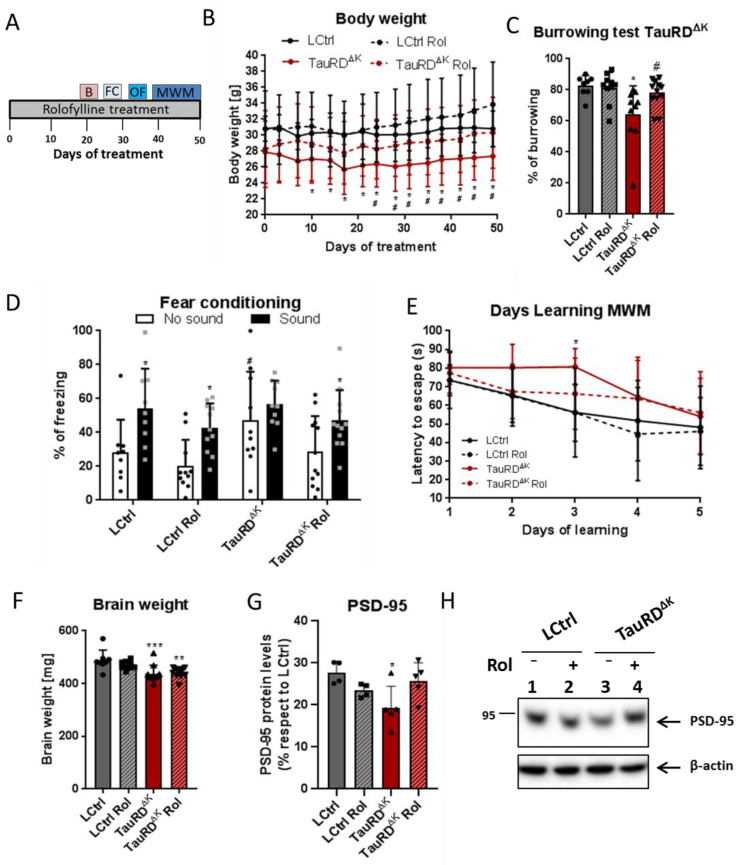Figure 3.
Rolofylline decreased cognitive deficits in TauRDΔK mice. Fifteen-month-old animals expressing TauRDΔK and their littermate controls were treated with rolofylline for 2.5 months, ~6 months after onset of cognitive decline. Data are expressed as a percentage mean ± SD. (A) Timeline of the behavior paradigms used during the treatment. (B) Rolofylline treatment prevented a decrease in body weight observed in animals expressing mutant TauRDΔK. Two-way ANOVA (n = 9–13 per group) revealed significant main effects of the factors of “time” (F(14, 546) = 11.79, p < 0.0001) and “treatment” (F(3, 39) = 3.27, p = 0.0314), as well as a significant factor interaction (F(42, 546) = 2.34, p < 0.0001). The latter indicates that body weight developed differently within groups. The body weight of LCtrl mice remained constant throughout the observation period. In contrast, the body weight of TauRDΔK mice was significantly different from LCtrl from day 10 onwards (Tukey’s post-hoc; * p < 0.05) and from rolofylline-treated LCtrls from day 24 onwards (Tukey’s post-hoc; # p < 0.05). Rolofylline-treated TauRDΔK Rol mice showed no statistical difference compared to control animals at any time point analyzed. (C) After 20 days of rolofylline treatment, TauRDΔK mice showed improved burrowing behavior (F(3, 36) = 4.87, p = 0.0061; n = 8–12 per group). There was a significant difference between LCtrl and TauRDΔK (Tukey’s post-hoc p = 0.0125; * p < 0.05 when compared to LCtrl) and between TauRDΔK and TauRDΔK Rol (p = 0.0471; # p < 0.05 when compared to TauRDΔK). LCtrl and TauRDΔK Rol were not significantly different with respect to burrowing (p = 0.8368). (D) Rolofylline treatment also improved performance in the fear conditioning test. There was a significant difference between contextual (no sound) and cue-induced (sound) freezing for LCtrl and LCtrl Rol (F(1, 76) = 19.62, p < 0.0001, Sidak’s post-hoc p < 0.05, black *), but not for TauRDΔK mice (p = 0.7525). Rolofylline-treated TauRDΔK Rol mice showed a statistic tendency (p = 0.0905, grey *). TauRDΔK mice showed more contextual freezing (no sound) than the other groups, which was significant compared to the LCtrl Rol group (F(3, 76) = 3.99, p = 0.0108, Sidak’s post-hoc p = 0.0138; #). (E) Rolofylline treatment improved learning speed of TauRDΔK mice in the Morris water maze test (Two-way ANOVA F(3, 39) = 3.56, p = 0.0227 for factor “treatment”, n = 9–13 per group). TauRDΔK mice needed more time to decrease the latency to escape, with a significant difference between LCtrl and TauRDΔK on learning day 3 (Dunnett’s post-hoc p = 0.0084, *). In contrast, there was no significant difference between LCtrl and TauRDΔK Rol (p > 0.28 on all days tested). (F) The loss in brain weight in TauRDΔK animals was not reversed by rolofylline treatment (F(3, 36) = 7.38, p = 0.0006, n = 8–12 per group). Both TauRDΔK and TauRDΔK Rol mice had significantly lighter brains compared to LCtrl (Dunnett’s post-hoc p = 0.0006 *** and 0.0022 **, respectively). (G) Protein levels of PSD-95 in the hippocampus of untreated TauRDΔK mice were significantly lower when compared to LCtrl (one-way ANOVA, F(3, 14) = 4, p = 0.0285; Tukey’s post-hoc p = 0.0263, *; n = 4–5/group); meanwhile, no differences were observed between LCtrl and rolofylline-treated TauRDΔK (p = 0.8637). There was no difference between transgenic animals, although PSD-95 had a clear trend to increase after rolofylline treatment (p = 0.0831). (H) Representative western blot of PSD-95.

